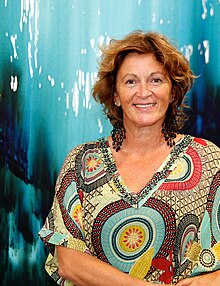Bronwyn Bancroft
| Bronwyn Bancroft | |
|---|---|

In Sydney, February 2010
|
|
| Born | 1958 (age 58–59) Tenterfield, New South Wales |
| Nationality | Australian |
| Notable work |
Prevention of AIDS (1992) Tempe Reserve sports centre (2004) |
Bronwyn Bancroft (born 1958) is an Australian artist, notable for being amongst the first Australian fashion designers invited to show her work in Paris. Born in Tenterfield, New South Wales, and trained in Canberra and Sydney, Bancroft worked as a fashion designer, and is an artist, illustrator, and arts administrator.
In 1985, Bancroft established a shop called Designer Aboriginals, selling fabrics made by Aboriginal artists including herself. She was a founding member of Boomalli Aboriginal Artists Co-operative. Art work by Bancroft is held by the National Gallery of Australia, the Art Gallery of New South Wales and the Art Gallery of Western Australia. She has provided art work for more than 20 children's books, including Stradbroke Dreaming by writer and activist Oodgeroo Noonuccal, and books by artist and writer Sally Morgan. She has received design commissions, including one for the exterior of a sports centre in Sydney.
Bancroft has a long history of involvement in community activism and arts administration, and has served as a board member for the National Gallery of Australia. Her painting Prevention of AIDS (1992) was used in a campaign to raise awareness of HIV/AIDS in Australia. Bancroft has served on the boards of copyright collection agency Viscopy and Tranby Aboriginal College, and the Artists Board at the Museum of Contemporary Art, Sydney.
A Bundjalung woman, Bancroft was born in Tenterfield, a town in rural New South Wales, in 1958. She was the youngest of seven children of Owen Cecil Joseph Bancroft, known as "Bill"—an Aboriginal Australian from the Djanbun clan—and Dot, who is of Scottish–Polish ancestry. Bancroft has said that her great-great-great-grandmother Pemau was one of only two or three survivors from her clan, the rest murdered when their land was settled by a white farmer. Her grandfather and uncle worked in local goldmines. She recalled that her father's education was obstructed by discrimination because he was Aboriginal. His lack of formal training meant that he had to work away from home cutting railroad sleepers, while her mother worked at home as a dressmaker. Bancroft's father was an engineer during World War II, managing barges at Madang and Rabaul.
...
Wikipedia
